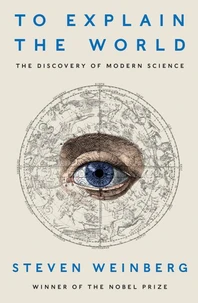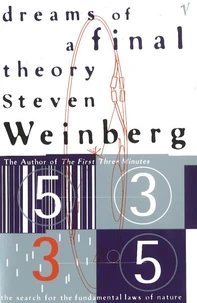Prix Nobel de la Physique
The Quantum Theory Of Fields Three Volumes Set : Volume 1, Foundations. Volume 2, Modern Applications. Volume 3, Supersymmetry
Par :Formats :
- Paiement en ligne :
- Livraison à domicile ou en point Mondial Relay indisponible
- Retrait Click and Collect en magasin gratuit
- Nombre de pages1517
- Poids3.375 kg
- Dimensions18,5 cm × 26,0 cm × 9,3 cm
- ISBN0-521-78082-9
- EAN9780521780827
- Date de parution21/03/2000
- ÉditeurCambridge University Press
Résumé
In The Quantum Theory of Fields Nobel Laureate Steven Weinberg combines his exceptional physical insight with his gift for clear exposition to provide a self-contained, comprehensive, and up-to-date introduction to quantum field theory.
Volume I introduces the foundations of quantum field theory. The development is fresh and logical throughout, with each step carefully motivated by what has gone before, and emphasizing the reasons why such a theory should describe nature. After a brief historical outline, the book begins anew with the principles about which we are most certain, relativity and quantum mechanics, and the properties of particles that follow from these principles. Quantum field theory then emerges from this as a natural consequence.
The classic calculations of quantum electrodynamics are presented in a thoroughly modern way, showing the use of path integrals and dimensional regularization. The account of renormalization theory reflects the changes in our view of quantum field theory since the advent of effective field theories.
The book's scope extends beyond quantum electrodynamics to elementary particle physics and nuclear physics. It contains much original material and is peppered with examples and insights drawn from the author's experience as a leader of elementary particle research. Problems are included at the end of each chapter.
A second volume will describe the modern applications of quantum field theory in today's standard model of elementary particles, and in some areas of condensed matter physics.
This will be an invaluable reference work for all physicists and mathematicians who use quantum field theory, as well as a textbook appropriate to graduate courses.
In The Quantum Theory of Fields Nobel Laureate Steven Weinberg combines his exceptional physical insight with his gift for clear exposition to provide a self-contained, comprehensive, and up-to-date introduction to quantum field theory.
Volume II gives an up-to-date and self-contained account of the methods of quantum field theory, and how they have led to an understanding of the weak, strong, and electromagnetic interactions of the elementary particles. The presentation of modern mathematical methods is throughout interwoven with accounts of the problems of elementary particle physics and condensed matter physics to which they have been applied. Topics are included that are not usually found in books on quantum field theory, such as the Batalin-Vilkovisky formalism and its application to renormalization and anomalies in gauge theories; the background field method; the effective field theory approach to symmetry breaking; critical phenomena; and superconductivity. The book contains original material, and is peppered with examples and insights from the author's experience as a leader of elementary particle physics. Problems are included at the end of each chapter.
This will be an invaluable reference work for all physicists and mathematicians who, use quantum field theory, as well as a textbook appropriate to graduate courses on quantum field theory.
In The Quantum Theory of Fields Nobel Laureate Steven Weinberg combines his exceptional physical insight with his gift for clear exposition to provide a self-contained, comprehensive, and up-to-date introduction to quantum field theory.
Volume III presents a self-contained, up-to-date and comprehensive introduction to supersymmetry, a highly active area of theoretical physics that is likely to be at the center of future progress in the physics of elementary particles and gravitation. The text introduces and explains a broad range of topics, including supersymmetric algebras, supersymmetric field theories, extended supersymmetry, supergraphs, non-perturbative results, theories of supersymmetry in higher dimensions, and supergravity. A thorough review is given of the phenomenological implications of supersymmetry, including theories of both gauge and gravitationally-mediated supersymmetry breaking. Also, provided is an introduction to mathematical techniques, based on holomorphy and duality; that have proved so, fruitful in recent developments. This book contains much material not found in other books on supersymmetry, some of it new. Problems are included at the end of each chapter.
This will be an invaluable reference work for all physicists and mathematicians who, use quantum field theory; as well as a textbook appropriate to graduate courses.
In The Quantum Theory of Fields Nobel Laureate Steven Weinberg combines his exceptional physical insight with his gift for clear exposition to provide a self-contained, comprehensive, and up-to-date introduction to quantum field theory.
Volume I introduces the foundations of quantum field theory. The development is fresh and logical throughout, with each step carefully motivated by what has gone before, and emphasizing the reasons why such a theory should describe nature. After a brief historical outline, the book begins anew with the principles about which we are most certain, relativity and quantum mechanics, and the properties of particles that follow from these principles. Quantum field theory then emerges from this as a natural consequence.
The classic calculations of quantum electrodynamics are presented in a thoroughly modern way, showing the use of path integrals and dimensional regularization. The account of renormalization theory reflects the changes in our view of quantum field theory since the advent of effective field theories.
The book's scope extends beyond quantum electrodynamics to elementary particle physics and nuclear physics. It contains much original material and is peppered with examples and insights drawn from the author's experience as a leader of elementary particle research. Problems are included at the end of each chapter.
A second volume will describe the modern applications of quantum field theory in today's standard model of elementary particles, and in some areas of condensed matter physics.
This will be an invaluable reference work for all physicists and mathematicians who use quantum field theory, as well as a textbook appropriate to graduate courses.
In The Quantum Theory of Fields Nobel Laureate Steven Weinberg combines his exceptional physical insight with his gift for clear exposition to provide a self-contained, comprehensive, and up-to-date introduction to quantum field theory.
Volume II gives an up-to-date and self-contained account of the methods of quantum field theory, and how they have led to an understanding of the weak, strong, and electromagnetic interactions of the elementary particles. The presentation of modern mathematical methods is throughout interwoven with accounts of the problems of elementary particle physics and condensed matter physics to which they have been applied. Topics are included that are not usually found in books on quantum field theory, such as the Batalin-Vilkovisky formalism and its application to renormalization and anomalies in gauge theories; the background field method; the effective field theory approach to symmetry breaking; critical phenomena; and superconductivity. The book contains original material, and is peppered with examples and insights from the author's experience as a leader of elementary particle physics. Problems are included at the end of each chapter.
This will be an invaluable reference work for all physicists and mathematicians who, use quantum field theory, as well as a textbook appropriate to graduate courses on quantum field theory.
In The Quantum Theory of Fields Nobel Laureate Steven Weinberg combines his exceptional physical insight with his gift for clear exposition to provide a self-contained, comprehensive, and up-to-date introduction to quantum field theory.
Volume III presents a self-contained, up-to-date and comprehensive introduction to supersymmetry, a highly active area of theoretical physics that is likely to be at the center of future progress in the physics of elementary particles and gravitation. The text introduces and explains a broad range of topics, including supersymmetric algebras, supersymmetric field theories, extended supersymmetry, supergraphs, non-perturbative results, theories of supersymmetry in higher dimensions, and supergravity. A thorough review is given of the phenomenological implications of supersymmetry, including theories of both gauge and gravitationally-mediated supersymmetry breaking. Also, provided is an introduction to mathematical techniques, based on holomorphy and duality; that have proved so, fruitful in recent developments. This book contains much material not found in other books on supersymmetry, some of it new. Problems are included at the end of each chapter.
This will be an invaluable reference work for all physicists and mathematicians who, use quantum field theory; as well as a textbook appropriate to graduate courses.












